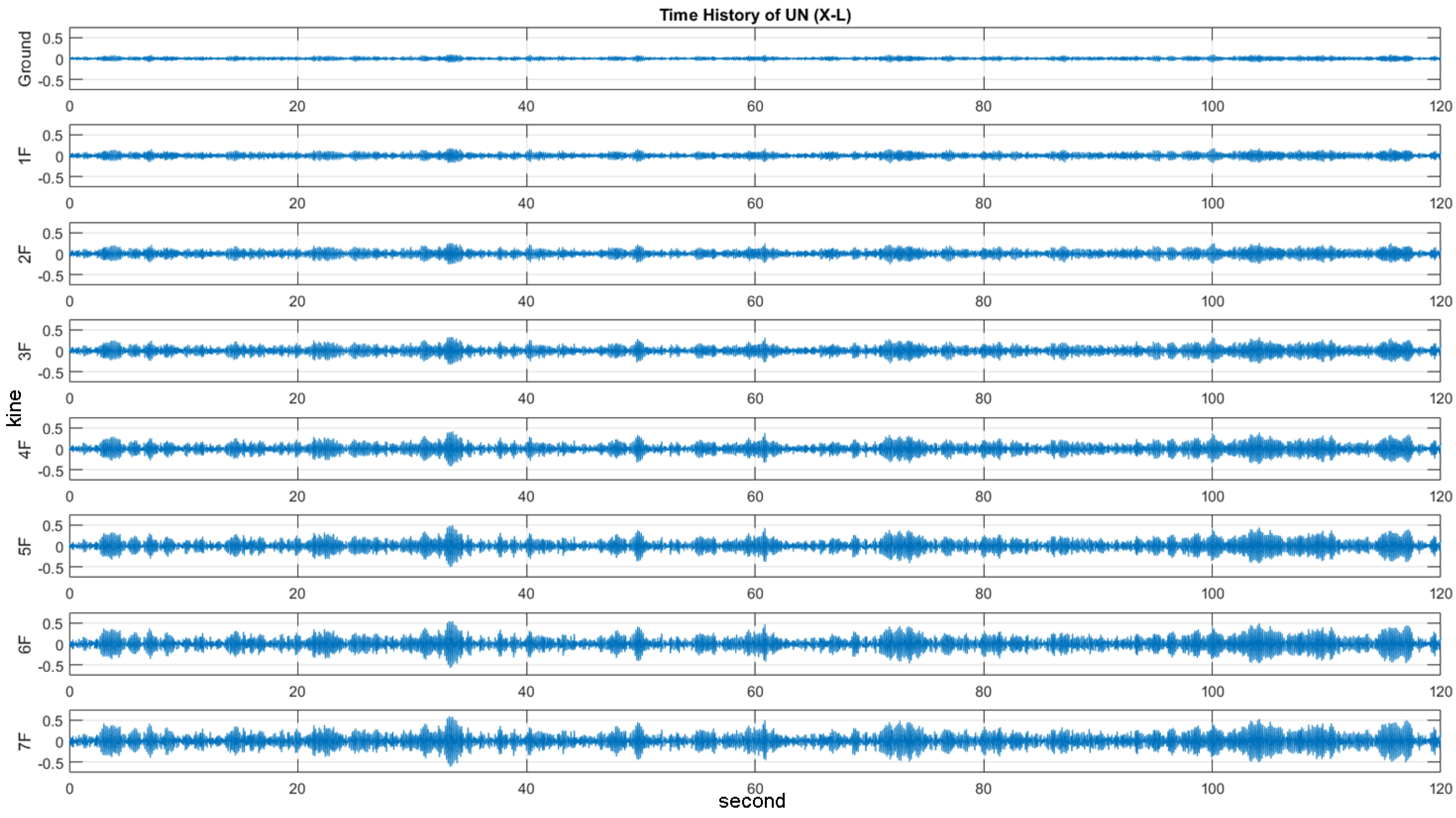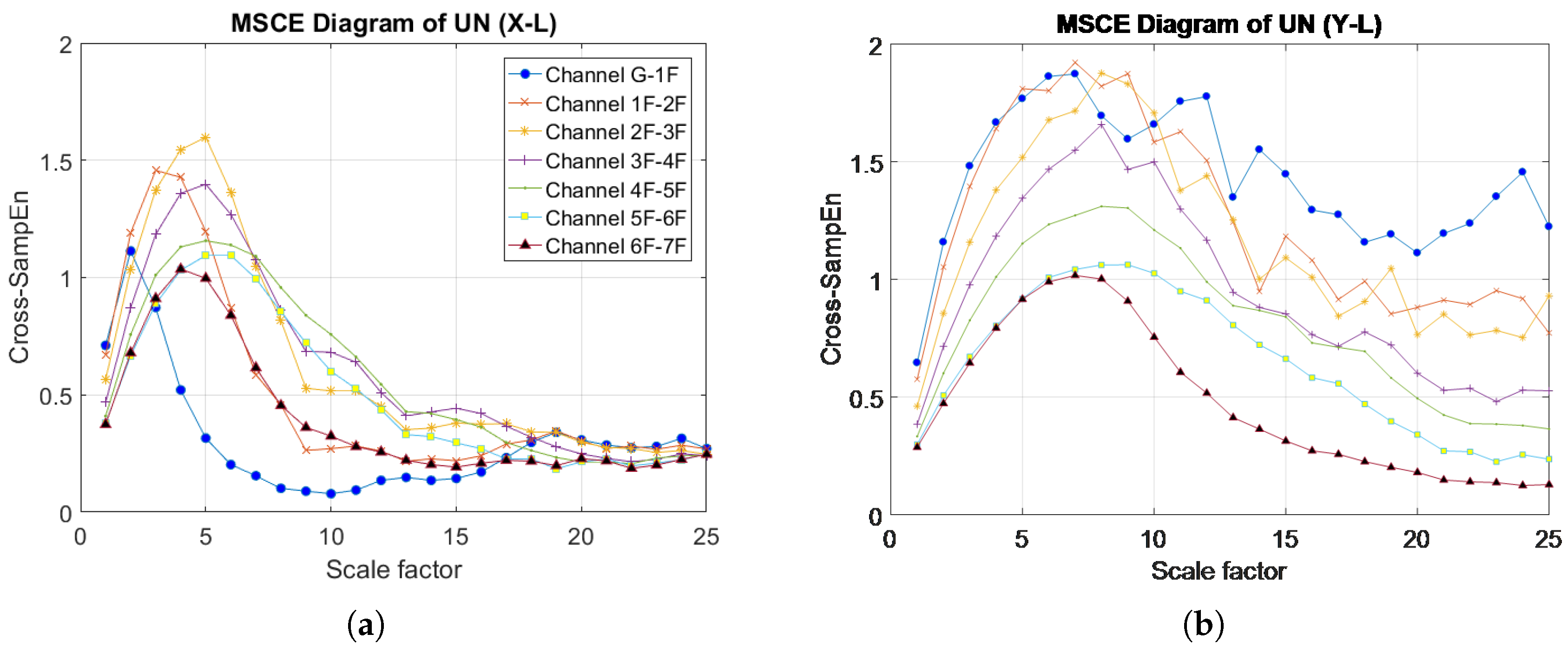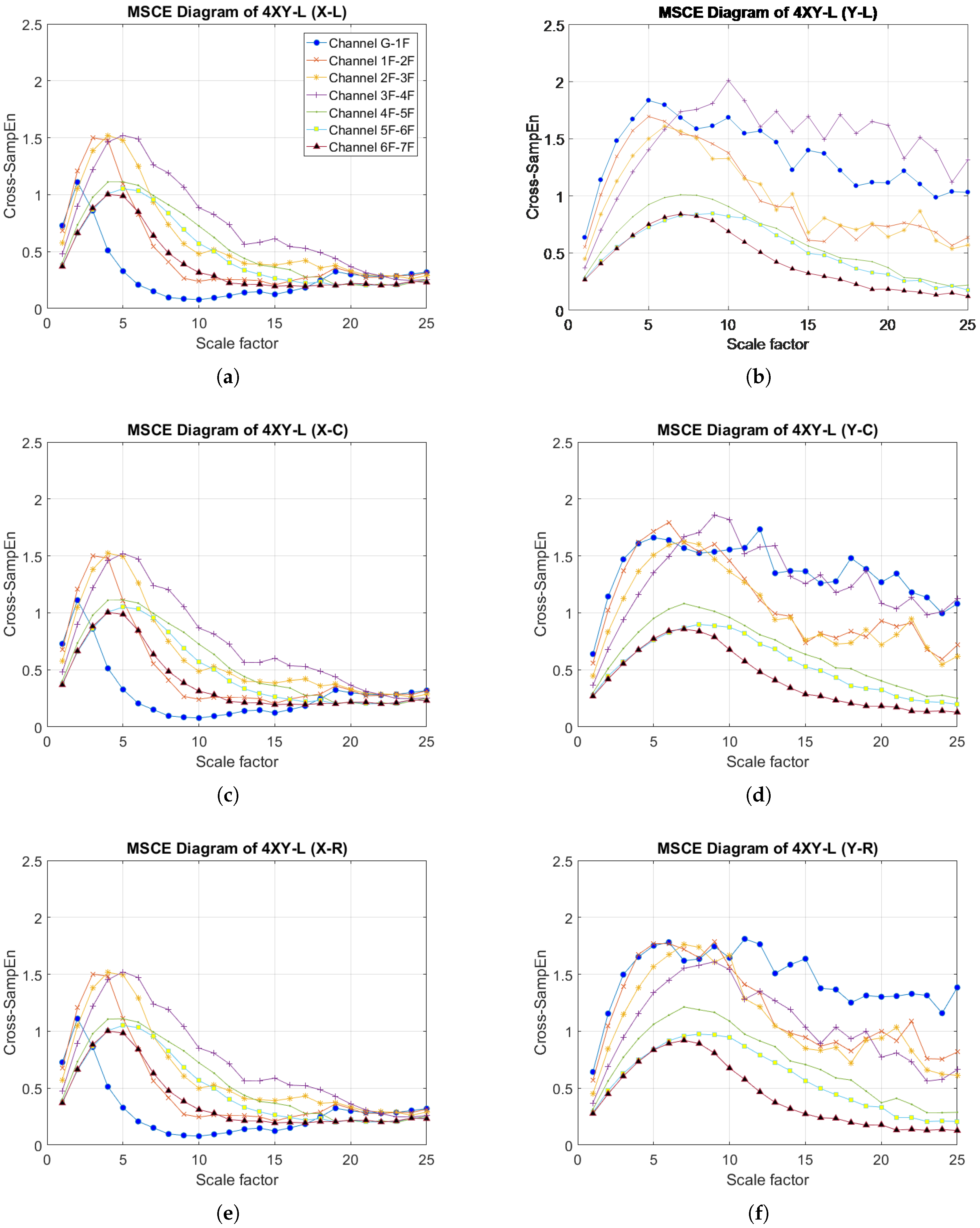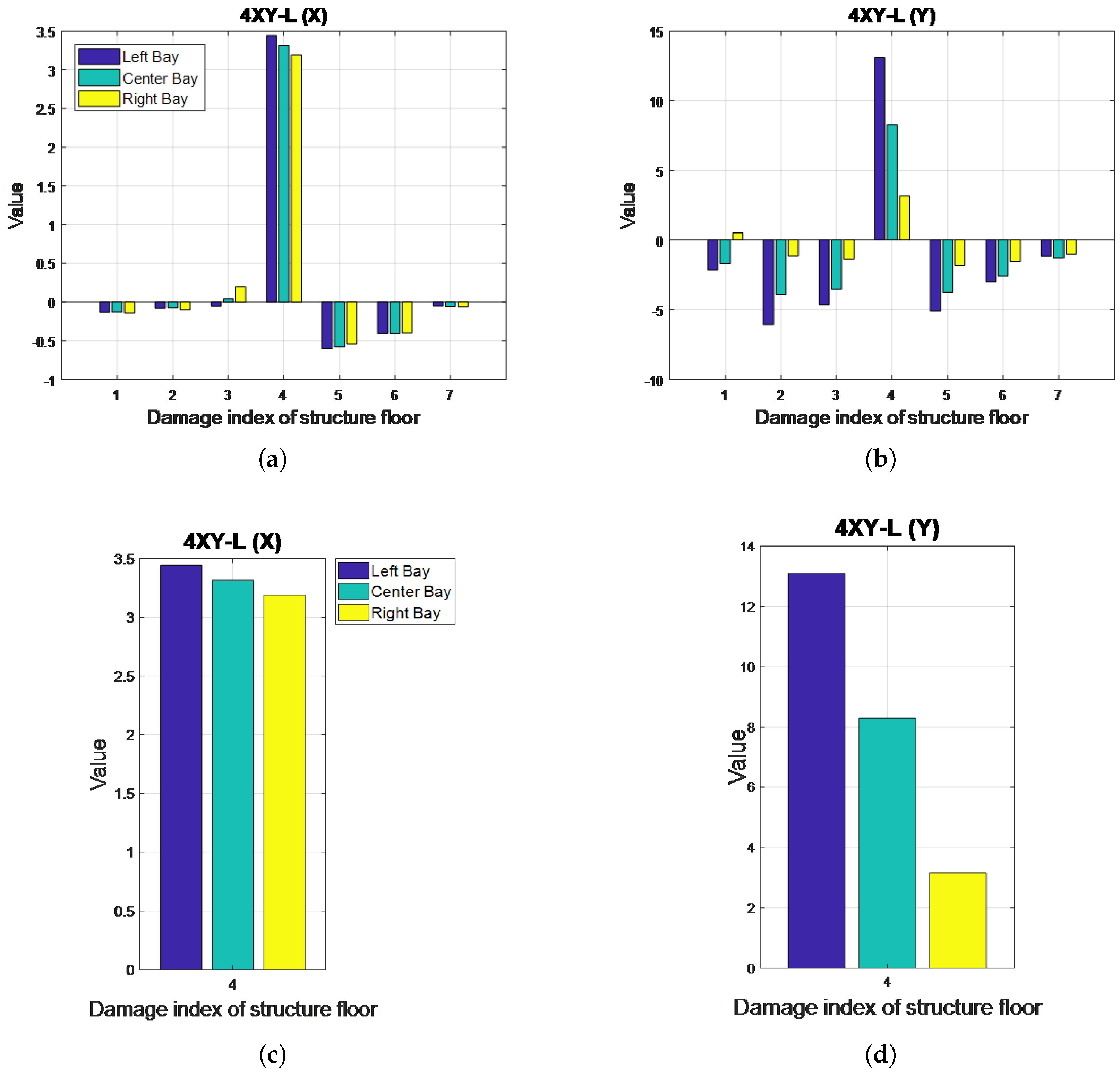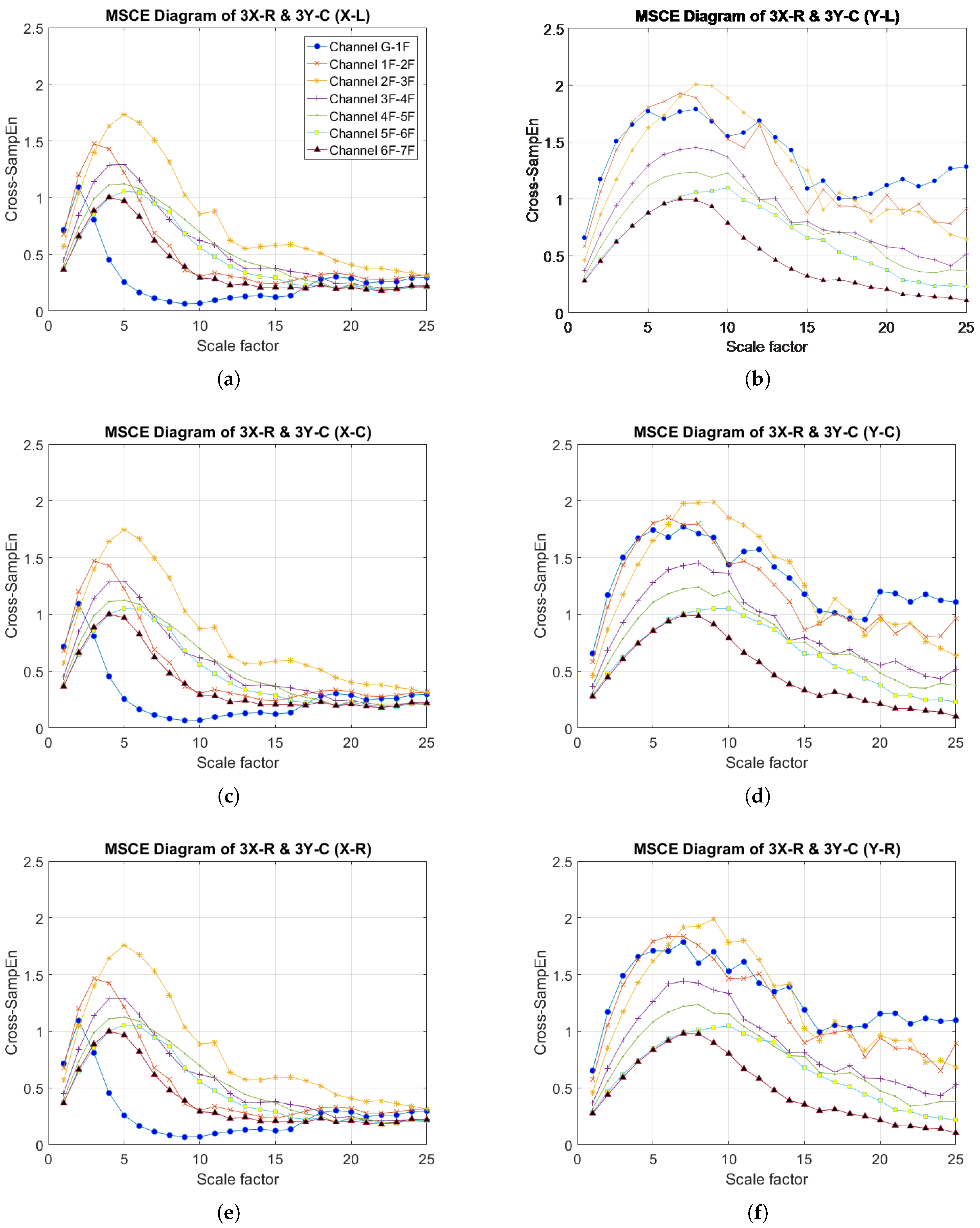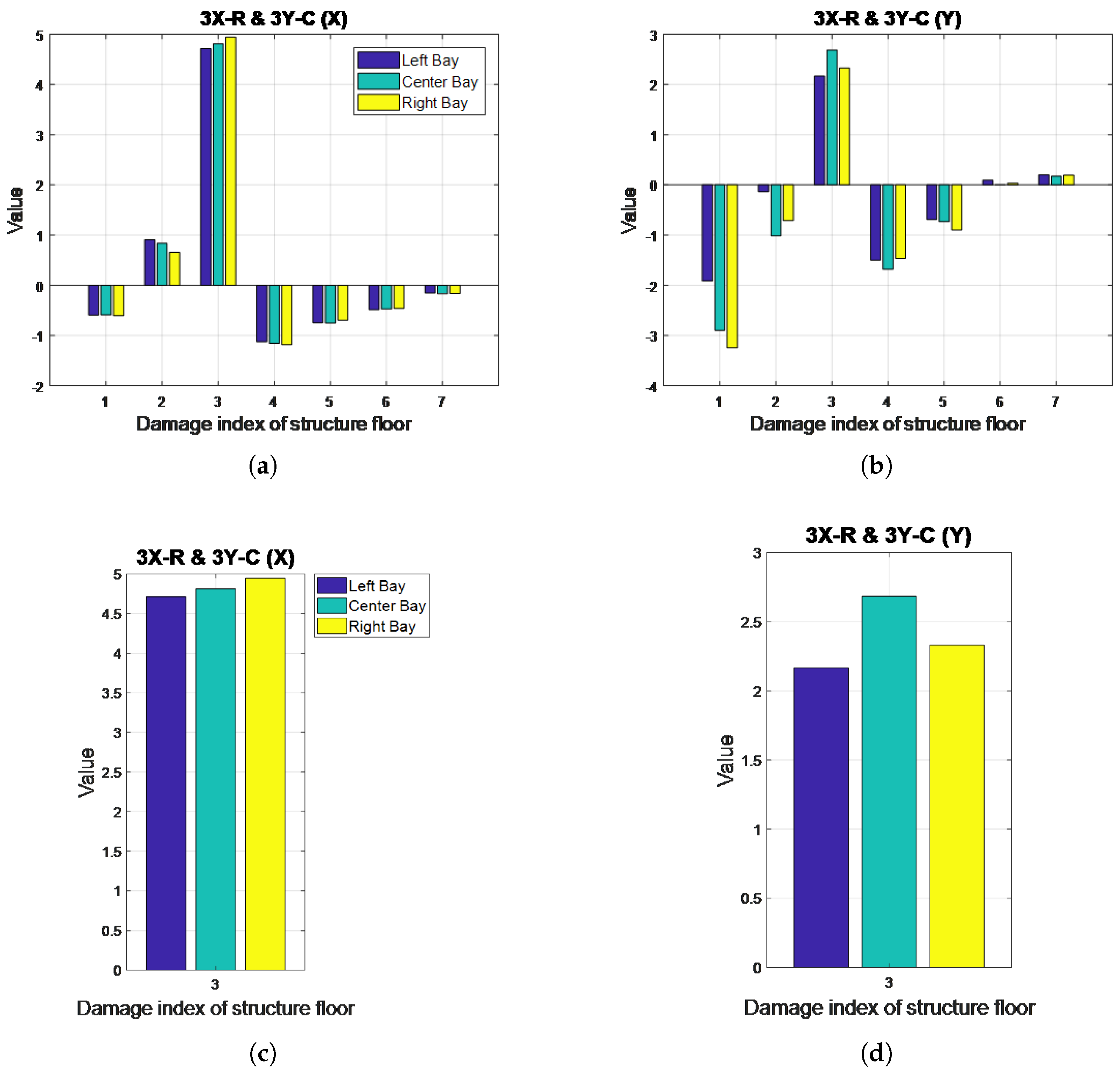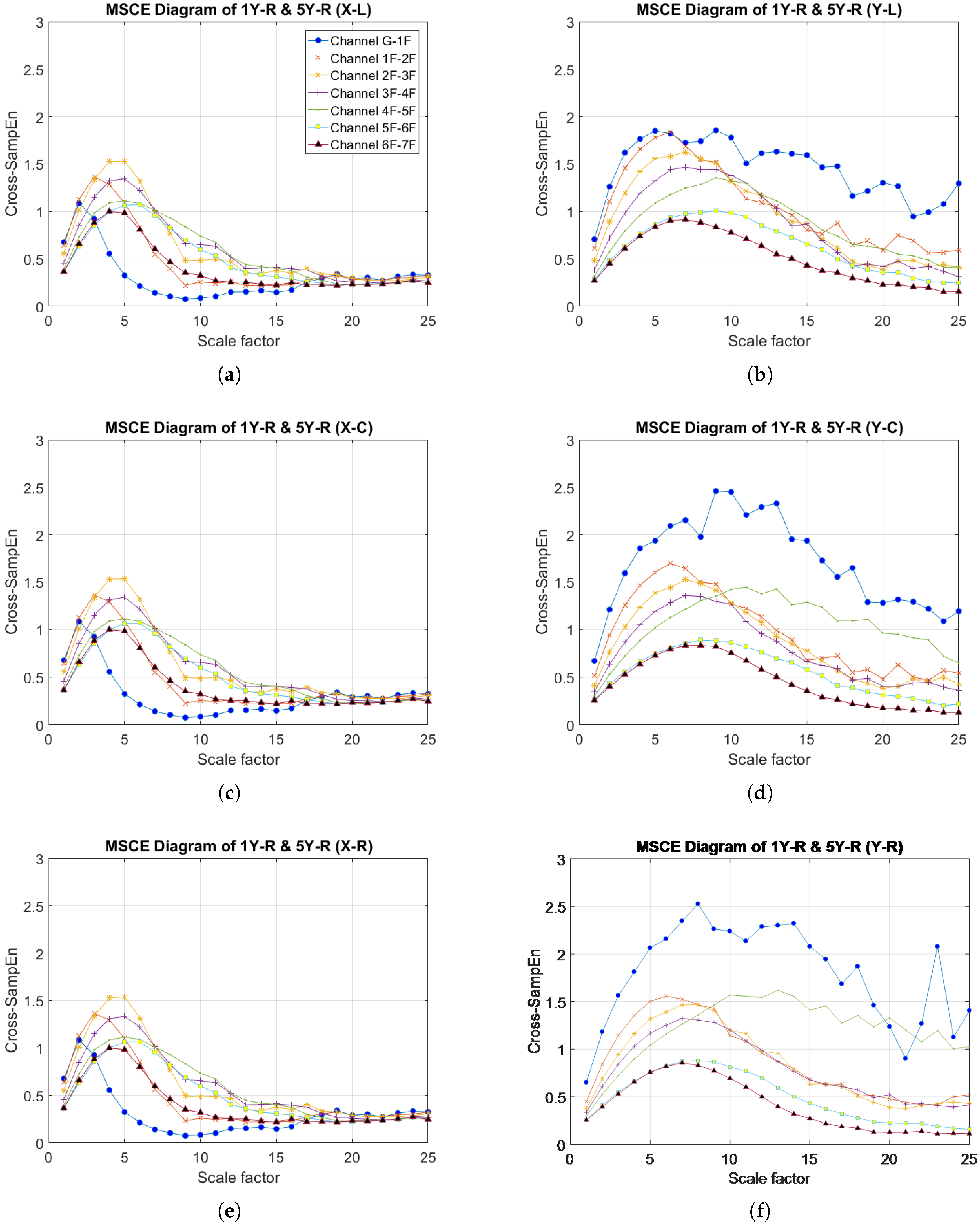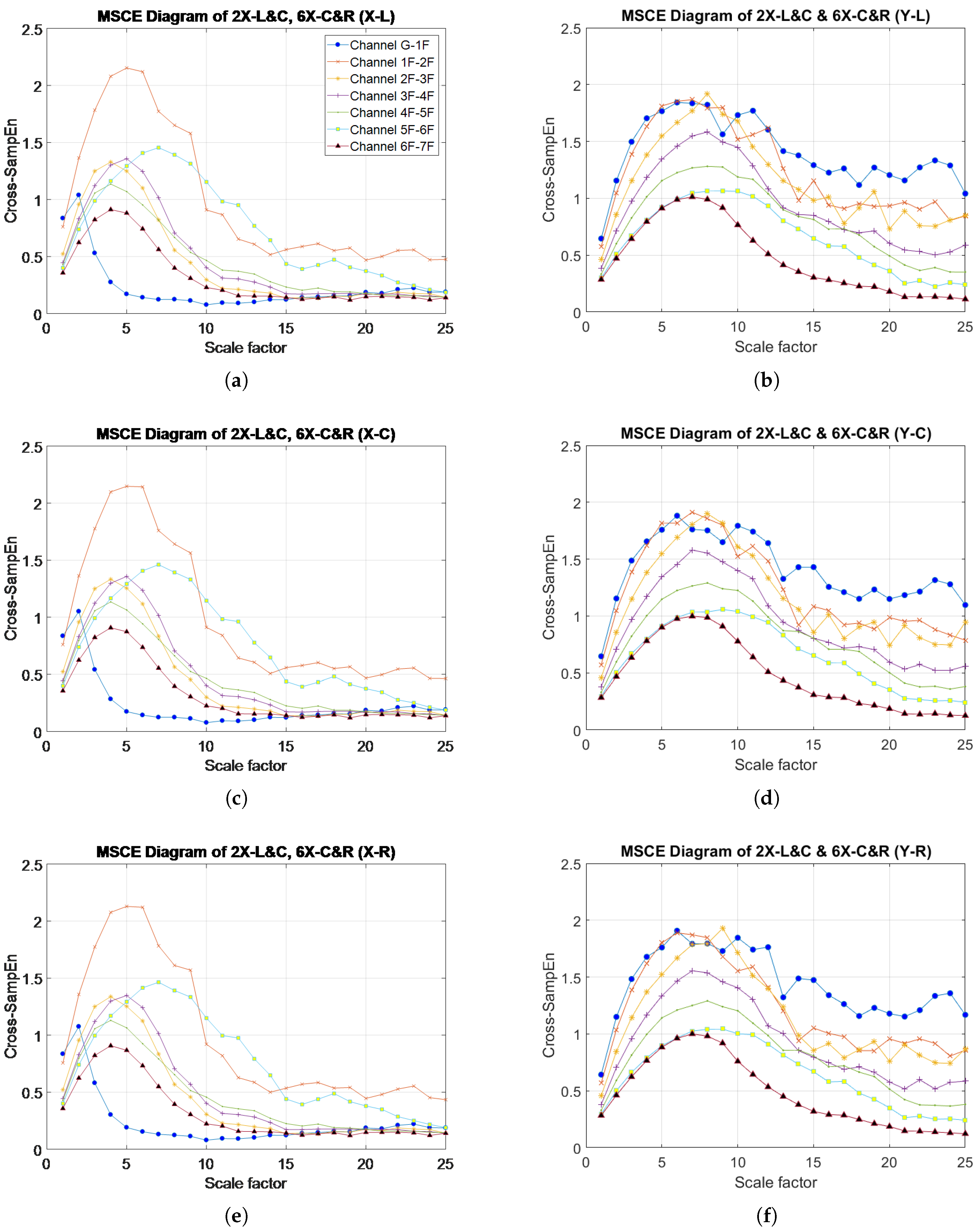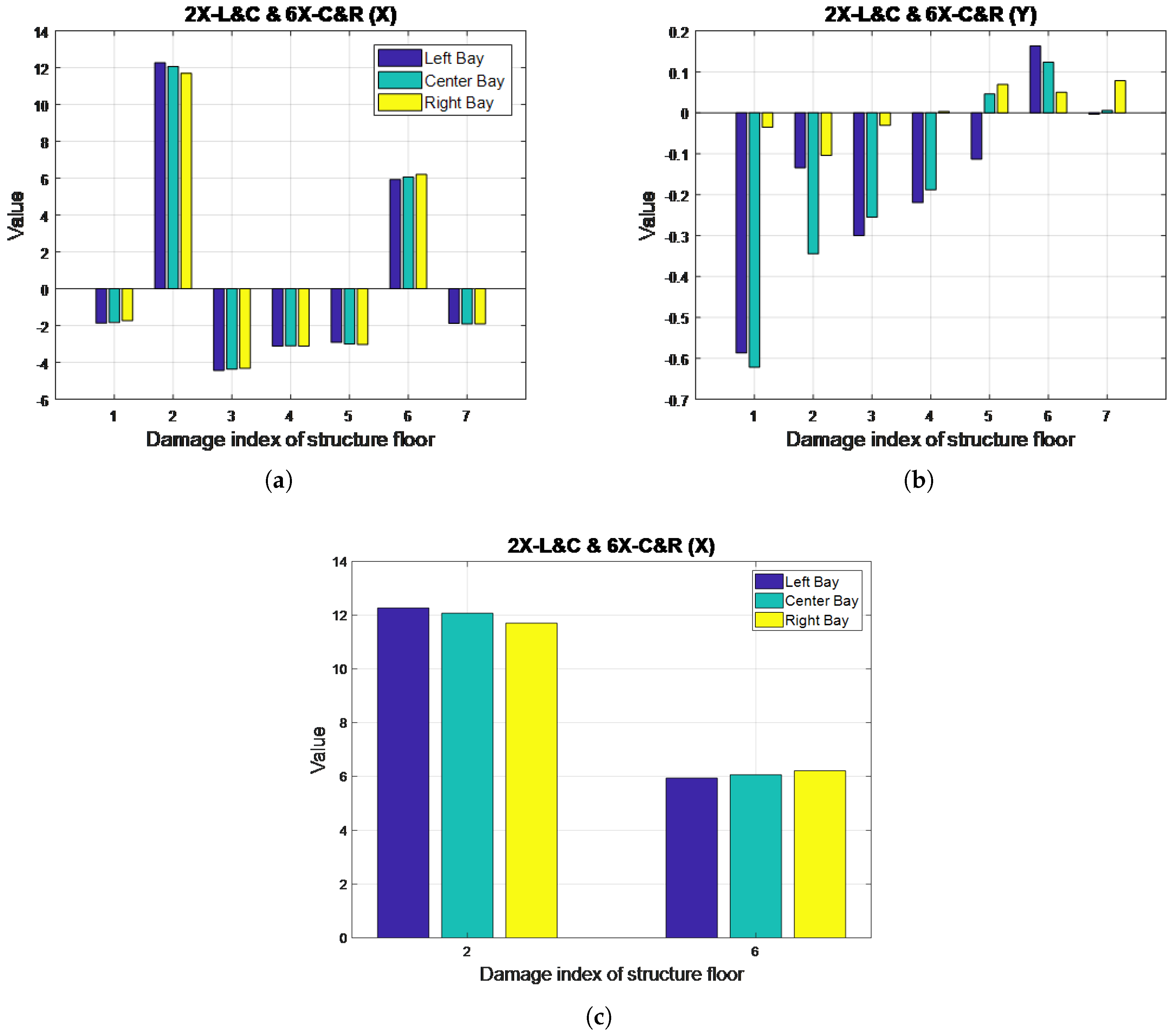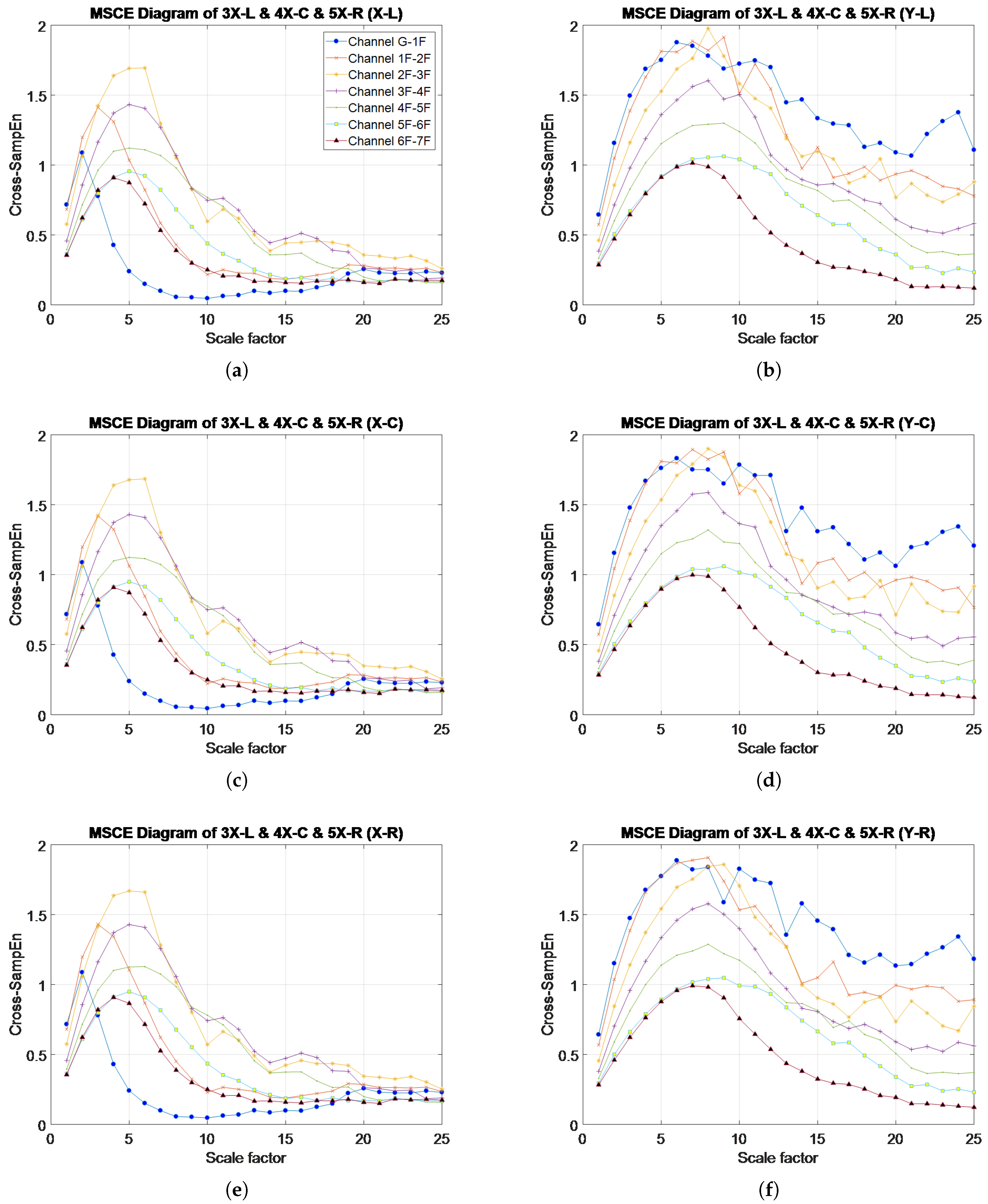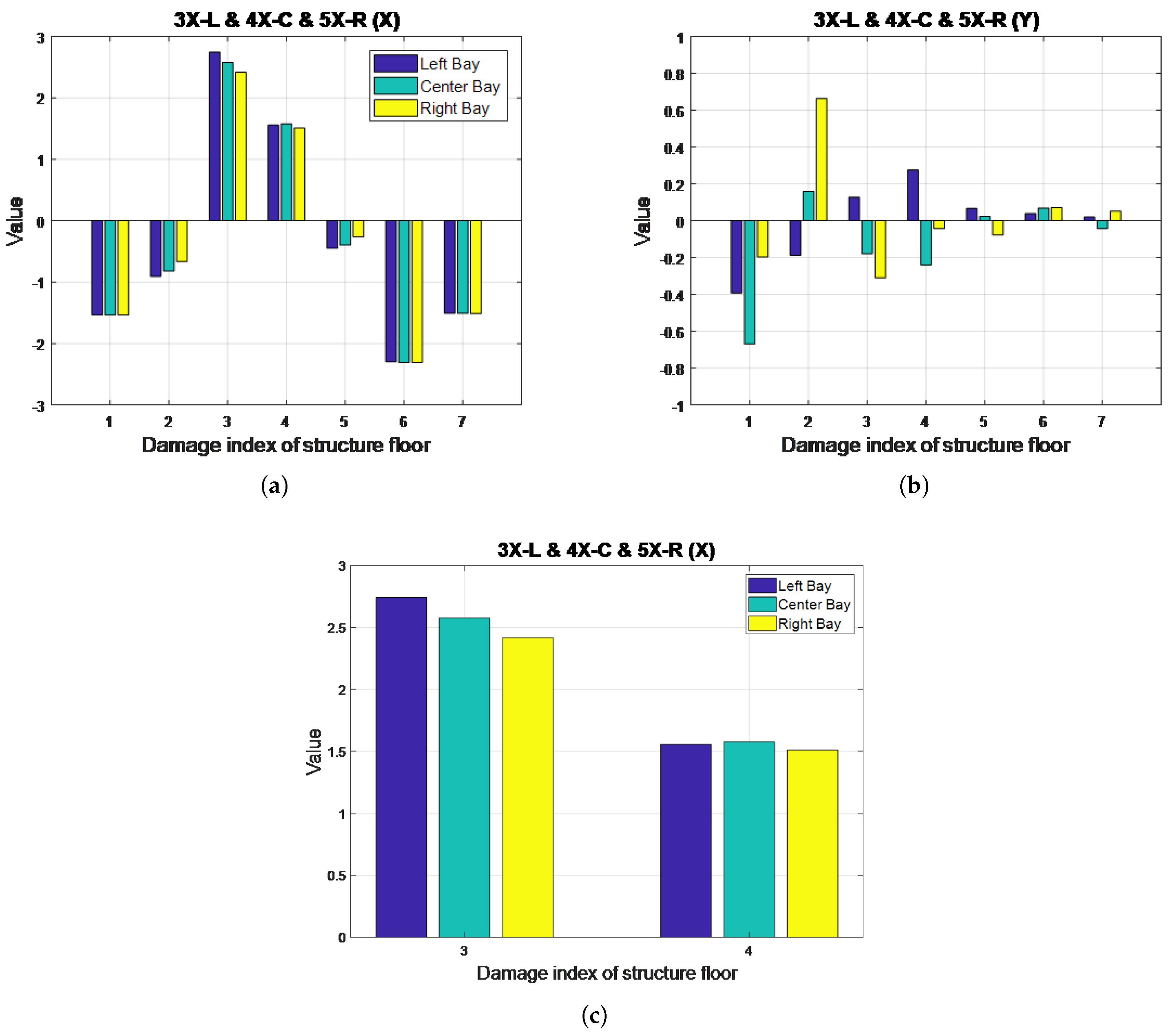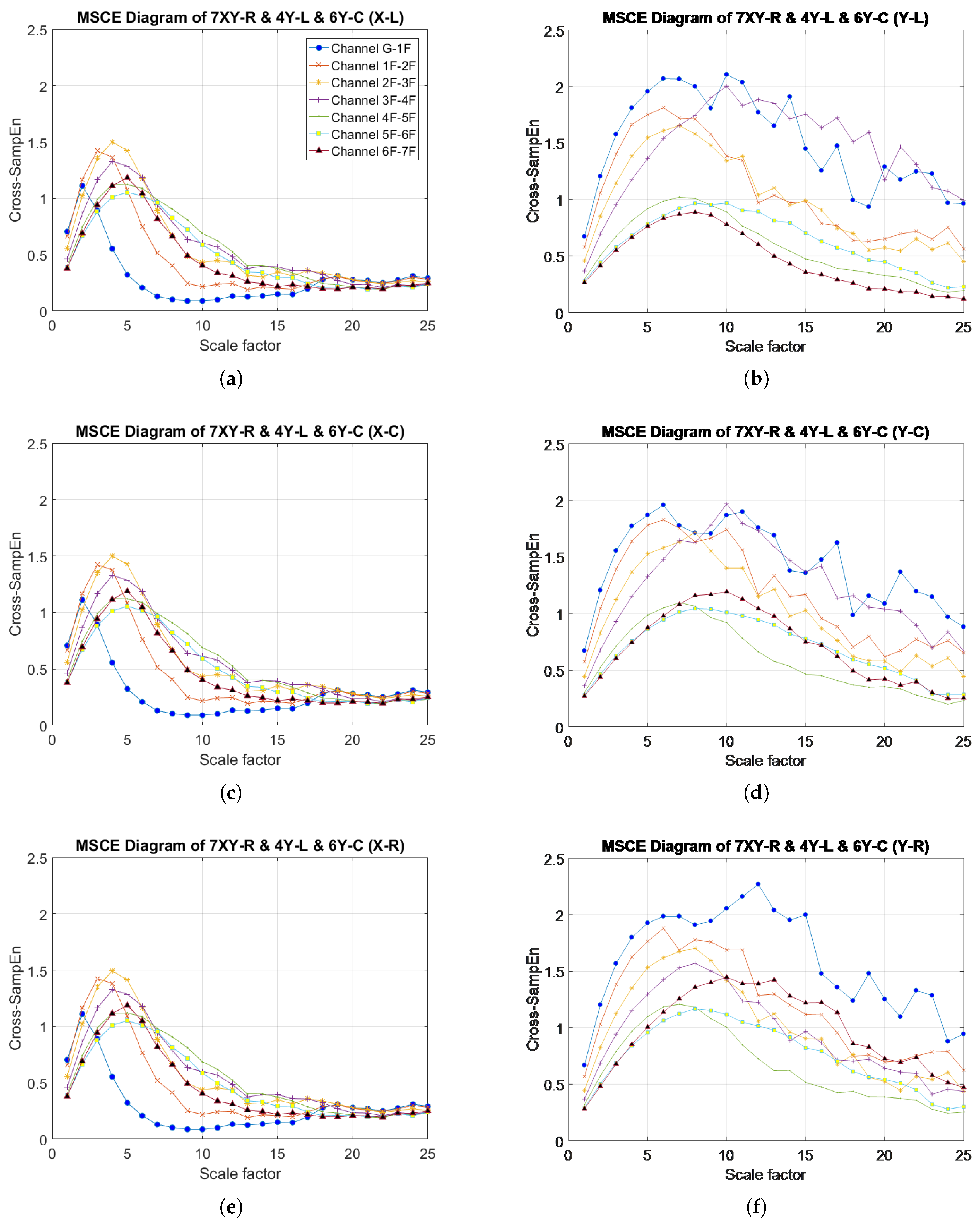Figure 1.
The time history of the velocity response of the undamaged scenario.
Figure 1.
The time history of the velocity response of the undamaged scenario.
Figure 2.
Signal extraction points.
Figure 2.
Signal extraction points.
Figure 3.
Three-dimensional view of the numerical model. The dotted braces represent the damaged bracing for Case 9 (6X-L & 6Y-R).
Figure 3.
Three-dimensional view of the numerical model. The dotted braces represent the damaged bracing for Case 9 (6X-L & 6Y-R).
Figure 4.
MSCE diagrams for undamaged condition: (a) left bay, X-direction; (b) left bay, Y-direction; (c) center bay, X-direction; (d) center bay, Y-direction; (e) right bay, X-direction; (f) right bay, Y-direction.
Figure 4.
MSCE diagrams for undamaged condition: (a) left bay, X-direction; (b) left bay, Y-direction; (c) center bay, X-direction; (d) center bay, Y-direction; (e) right bay, X-direction; (f) right bay, Y-direction.
Figure 5.
MSCE diagrams for Case 4: damage on fourth floor, left bay, X- and Y-directions: (a) left bay, X-direction; (b) left bay, Y-direction; (c) center bay, X-direction; (d) center bay, Y-direction; (e) right bay, X-direction; (f) right bay, Y-direction.
Figure 5.
MSCE diagrams for Case 4: damage on fourth floor, left bay, X- and Y-directions: (a) left bay, X-direction; (b) left bay, Y-direction; (c) center bay, X-direction; (d) center bay, Y-direction; (e) right bay, X-direction; (f) right bay, Y-direction.
Figure 6.
Damage index (DI) diagrams for Case 4: (a) X-direction; (b) Y-direction; (c) close up of DI diagrams for the fourth floor in Case 4: X direction; (d) Y-direction.
Figure 6.
Damage index (DI) diagrams for Case 4: (a) X-direction; (b) Y-direction; (c) close up of DI diagrams for the fourth floor in Case 4: X direction; (d) Y-direction.
Figure 7.
MSCE diagrams for Case 8: damage on the third floor, right bay, X-direction and third floor, center bay, Y-direction: (a) left bay, X-direction; (b) left bay, Y-direction; (c) center bay, X-direction; (d) center bay, Y-direction; (e) right bay, X-direction; (f) right bay, Y-direction.
Figure 7.
MSCE diagrams for Case 8: damage on the third floor, right bay, X-direction and third floor, center bay, Y-direction: (a) left bay, X-direction; (b) left bay, Y-direction; (c) center bay, X-direction; (d) center bay, Y-direction; (e) right bay, X-direction; (f) right bay, Y-direction.
Figure 8.
DI diagrams for Case 8: (a) X-direction; (b) Y-direction; close-up of DI diagrams for the third floor in Case 8: (c) X-direction; (d) Y-direction.
Figure 8.
DI diagrams for Case 8: (a) X-direction; (b) Y-direction; close-up of DI diagrams for the third floor in Case 8: (c) X-direction; (d) Y-direction.
Figure 9.
MSCE diagrams for Case 11: damage on first floor, right bay, Y-direction and fifth floor, right bay, Y-direction: (a) left bay, X-direction; (b) left bay, Y-direction; (c) center bay, X-direction; (d) center bay, Y-direction; (e) right bay, X-direction; (f) right bay, Y-direction.
Figure 9.
MSCE diagrams for Case 11: damage on first floor, right bay, Y-direction and fifth floor, right bay, Y-direction: (a) left bay, X-direction; (b) left bay, Y-direction; (c) center bay, X-direction; (d) center bay, Y-direction; (e) right bay, X-direction; (f) right bay, Y-direction.
Figure 10.
DI diagrams for Case 11: (a) X-direction; (b) Y-direction; (c) close-up of DI diagrams for the first and fifth floors in Case 11 (Y-direction).
Figure 10.
DI diagrams for Case 11: (a) X-direction; (b) Y-direction; (c) close-up of DI diagrams for the first and fifth floors in Case 11 (Y-direction).
Figure 11.
MSCE diagrams for Case 16: damage on second floor, left and center bays, X-direction and sixth floor, center and right bays, X-direction: (a) left bay, X-direction; (b) left bay, Y-direction; (c) center bay, X-direction; (d) center bay, Y-direction; (e) right bay, X-direction; (f) right bay, Y-direction.
Figure 11.
MSCE diagrams for Case 16: damage on second floor, left and center bays, X-direction and sixth floor, center and right bays, X-direction: (a) left bay, X-direction; (b) left bay, Y-direction; (c) center bay, X-direction; (d) center bay, Y-direction; (e) right bay, X-direction; (f) right bay, Y-direction.
Figure 12.
DI diagrams for Case 16: (a) X-direction; (b) Y-direction; (c) close-up of DI diagrams for the second and sixth floors in Case 16 (X-direction).
Figure 12.
DI diagrams for Case 16: (a) X-direction; (b) Y-direction; (c) close-up of DI diagrams for the second and sixth floors in Case 16 (X-direction).
Figure 13.
MSCE diagrams for Case 23: damage on the third floor, left bay, X-direction; fourth floor, center bay, X-direction; fifth floor, right bay, X-direction: (a) left bay, X-direction; (b) left bay, Y-direction; (c) center bay, X-direction; (d) center bay, Y-direction; (e) right bay, X-direction; (f) right bay, Y-direction.
Figure 13.
MSCE diagrams for Case 23: damage on the third floor, left bay, X-direction; fourth floor, center bay, X-direction; fifth floor, right bay, X-direction: (a) left bay, X-direction; (b) left bay, Y-direction; (c) center bay, X-direction; (d) center bay, Y-direction; (e) right bay, X-direction; (f) right bay, Y-direction.
Figure 14.
DI diagrams for Case 23: (a) X-direction; (b) Y-direction; (c) close-up of DI diagrams for the third and fourth floors in Case 23 (X-direction).
Figure 14.
DI diagrams for Case 23: (a) X-direction; (b) Y-direction; (c) close-up of DI diagrams for the third and fourth floors in Case 23 (X-direction).
Figure 15.
MSCE diagrams for Case 26: damage on seventh floor, right bay, X- and Y-directions; fourth floor, left bay, Y-direction; sixth floor, center bay, Y-direction: (a) left bay, X-direction; (b) left bay, Y-direction; (c) center bay, X-direction; (d) center bay, Y-direction; (e) right bay, X-direction; (f) right bay, Y-direction.
Figure 15.
MSCE diagrams for Case 26: damage on seventh floor, right bay, X- and Y-directions; fourth floor, left bay, Y-direction; sixth floor, center bay, Y-direction: (a) left bay, X-direction; (b) left bay, Y-direction; (c) center bay, X-direction; (d) center bay, Y-direction; (e) right bay, X-direction; (f) right bay, Y-direction.
Figure 16.
DI diagrams for Case 26: (a) X-direction; (b) Y-direction; (c) seventh floor, X-direction; (d) fourth, sixth and seventh floor, Y-direction.
Figure 16.
DI diagrams for Case 26: (a) X-direction; (b) Y-direction; (c) seventh floor, X-direction; (d) fourth, sixth and seventh floor, Y-direction.
Table 1.
Numerical setting of the finite element model.
Table 1.
Numerical setting of the finite element model.
| Parameter | Setting |
|---|
| Constitutive equation | Linear elastic |
| Material | A36 steel |
| DOF of the foundation | Fixed in 6 DOF |
| Finite element for column, beam and bracing | Beam |
| Integration method | Direct-integration time-history analysis |
| Duration | 150 s |
| Ambient vibration | White noise of 1 mW power |
Table 2.
Damage cases for analysis.
Table 2.
Damage cases for analysis.
| Case Number | Damage Group | Damaged Floor, Direction and Bay |
|---|
| 1 | Single-story, single-bay, single-direction | 5X-L |
| 2 | 3Y-C |
| 3 | 7Y-R |
| 4 | Single-story, single-bay, multidirectional | 4XY-L |
| 5 | 6XY-C |
| 6 | Single-story, multi-bay, single-direction | 2X-L & 2X-C |
| 7 | 5Y-L & 5Y-C & 5Y-R |
| 8 | Single-story, multi-bay, multidirectional | 3X-R & 3Y-C |
| 9 | 6X-L & 6Y-R |
| 10 | Two-story, single-bay, single-direction | 3X-L & 6X-L |
| 11 | 1Y-R & 5Y-R |
| 12 | Two-story, single-bay, multidirectional | 4X-C & 7Y-C |
| 13 | 2XY-R & 3XY-R |
| 14 | Two-story, multi-bay, single-direction | 5X-R & 7X-L |
| 15 | 2Y-C & 4Y-R |
| 16 | 2X-L & C, 6X-C & R |
| 17 | Two-story, multi-bay, multidirectional | 4X-R & 2Y-L |
| 18 | 6XY-R & 7XY-L |
| 19 | Multistory, single-bay, single-direction | 3X-L & 4X-L & 6X-L |
| 20 | 1Y-R & 4Y-R & 7Y-R |
| 21 | Multistory, single-bay, multidirectional | 4X-L & 5Y-L & 6Y-L |
| 22 | 1XY-C & 3XY-C & 5XY-C |
| 23 | Multistory, multi-bay, single-direction | 3X-L & 4X-C & 5X-R |
| 24 | 6Y-L & 2Y-C & 7Y-R |
| 25 | Multistory, multi-bay, multidirectional | 1X-R & 2X-R & 1Y-L |
| 26 | 7XY-R & 4Y-L & 6Y-C |
Table 3.
Modal analysis of the numerical model.
Table 3.
Modal analysis of the numerical model.
| Case No. | Damage Case | Frequency (Hz) |
|---|
| Mode 1(X) | Mode 2(X) | Mode 1(Y) | Mode 2(Y) |
|---|
| | Undamaged (UN) | 6.5 | 19.52 | 2.69 | 11.56 |
| 1 | 5X-L | 6.41 | 18.84 | 2.69 | 11.56 |
| 2 | 3Y-C | 6.50 | 19.53 | 2.65 | 11.55 |
| 3 | 7Y-R | 6.50 | 17.97 | 2.68 | 11.02 |
| 4 | 4XY-L | 6.12 | 18.69 | 2.60 | 11.32 |
| 5 | 6XY-C | 6.44 | 18.58 | 2.68 | 11.15 |
| 6 | 2X-L & 2X-C | 5.78 | 18.93 | 2.69 | 11.57 |
| 7 | 5Y-L & 5Y-C & 5Y-R | 6.27 | 17.41 | 2.44 | 8.88 |
| 8 | 3X-R & 3Y-C | 6.32 | 19.52 | 2.65 | 11.55 |
| 9 | 6X-L & 6Y-R | 6.43 | 17.02 | 2.66 | 10.48 |
| 10 | 3X-L & 6X-L | 6.29 | 18.81 | 2.69 | 11.57 |
| 11 | 1Y-R & 5Y-R | 5.88 | 17.55 | 2.49 | 9.21 |
| 12 | 4X-C & 7Y-C | 6.32 | 19.09 | 2.69 | 11.36 |
| 13 | 2XY-R & 3XY-R | 5.41 | 18.23 | 2.39 | 10.86 |
| 14 | 5X-R & 7X-L | 6.42 | 18.55 | 2.69 | 11.56 |
| 15 | 2Y-C & 4Y-R | 6.3 | 19.16 | 2.55 | 11.02 |
| 16 | 2X-L & C, 6X-C & R | 5.67 | 16.21 | 2.69 | 11.57 |
| 17 | 4X-R & 2Y-L | 5.91 | 18.66 | 2.57 | 11.00 |
| 18 | 6XY-R & 7XY-L | 6.43 | 15.50 | 2.66 | 10.19 |
| 19 | 3X-L & 4X-L & 6X-L | 6.13 | 18.52 | 2.69 | 11.57 |
| 20 | 1Y-R & 4Y-R & 7Y-R | 5.78 | 16.13 | 2.45 | 9.33 |
| 21 | 4X-L & 5Y-L & 6Y-L | 6.29 | 17.56 | 2.59 | 9.96 |
| 22 | 1XY-C & 3XY-C & 5XY-C | 5.92 | 18.07 | 2.57 | 10.54 |
| 23 | 3X-L & 4X-C & 5X-R | 6.12 | 18.46 | 2.70 | 11.57 |
| 24 | 6Y-L & 2Y-C & 7Y-R | 6.49 | 16.44 | 2.60 | 9.94 |
| 25 | 1X-R & 2X-R & 1Y-L | 5.67 | 18.09 | 2.56 | 10.40 |
| 26 | 7XY-R & 4Y-L & 6Y-C | 6.27 | 15.94 | 2.59 | 10.52 |
Table 4.
Classification results of DI analysis.
Table 4.
Classification results of DI analysis.
| Case Number | Damage Group | Damage Case | Damage Index (X-Direction) | Damage Index (Y-Direction) |
|---|
| 1 | Single-story, | 5X-L | OK | OK |
| 2 | single-bay, | 3Y-C | OK | OK |
| 3 | single-direction | 7Y-R | OK | 1F |
| 4 | Single-story, single- | 4XY-L | OK | OK |
| 5 | bay, multi-directional | 6XY-C | 6F | OK |
| 6 | Single-story, multi- | 2X-L & 2X-C | 2F | OK |
| 7 | bay, single-direction | 5Y-L & 5Y-C & 5Y-R | OK | 5F |
| 8 | Single-story, multi- | 3X-R & 3Y-C | OK | OK |
| 9 | bay, multidirectional | 6X-L & 6Y-R | OK | 1F |
| 10 | Two-story, single-bay, | 3X-L & 6X-L | OK | OK |
| 11 | single-direction | 1Y-R & 5Y-R | OK | OK |
| 12 | Two-story, single-bay, | 4X-C & 7Y-C | OK | OK |
| 13 | multidirectional | 2XY-R & 3XY-R | OK | |
| 14 | Two-story, | 5X-R & 7X-L | OK | OK |
| 15 | multi-bay, | 2Y-C & 4Y-R | OK | 1F & 2F |
| 16 | single-direction | 2X-L & C, 6X-C & R | 2F & 6F | OK |
| 17 | Two-story, multi- | 4X-R & 2Y-L | OK | 1F |
| 18 | bay, multidirectional | 6XY-R & 7XY-L | OK | 1F & 2F |
| 19 | Multistory, single- | 3X-L & 4X-L & 6X-L | 6F | OK |
| 20 | bay, single-direction | 1Y-R & 4Y-R & 7Y-R | OK | OK |
| 21 | Multistory, single- | 4X-L & 5Y-L & 6Y-L | OK | 1F & 2F |
| 22 | bay, multidirectional | 1XY-C & 3XY-C & 5XY-C | 1F & 5F | 1F & 3F |
| 23 | Multistory, multi-bay, | 3X-L & 4X-C & 5X-R | 5F | OK |
| 24 | single-direction | 6Y-L & 2Y-C & 7Y-R | OK | 1F & 2F |
| 25 | Multistory, multi-bay, | 1X-R & 2X-R & 1Y-L | 1F & 2F | OK |
| 26 | multidirectional | 7XY-R & 4Y-L & 6Y-C | OK | 1F & 6F |
Table 5.
Precision and recall analysis results (X- and Y-directions).
Table 5.
Precision and recall analysis results (X- and Y-directions).
| Direction | True Positives | False Positives | True Negatives | False Negatives | Precision | Recall |
|---|
| X | 25 | 0 | 151 | 6 | 100% | 81% |
| Y | 30 | 11 | 139 | 2 | 73% | 94% |
| Total | 55 | 11 | 290 | 8 | 83% | 87% |
Table 6.
Identification accuracy of damaged bays (X- and Y-directions).
Table 6.
Identification accuracy of damaged bays (X- and Y-directions).
| Direction | Damage Instances | Correctly Identified Bay | Accuracy |
|---|
| X | 34 | 24 | 71% |
| Y | 34 | 27 | 79% |
| Total | 68 | 51 | 75% |
